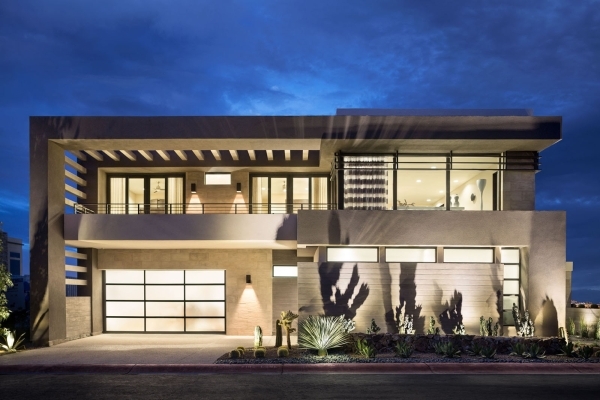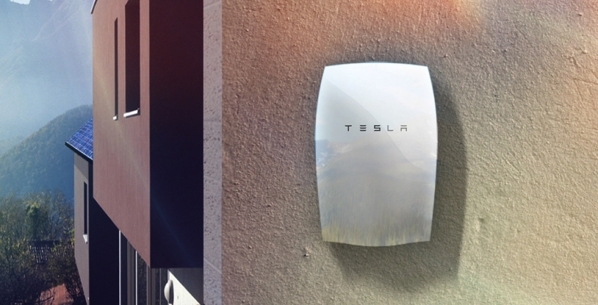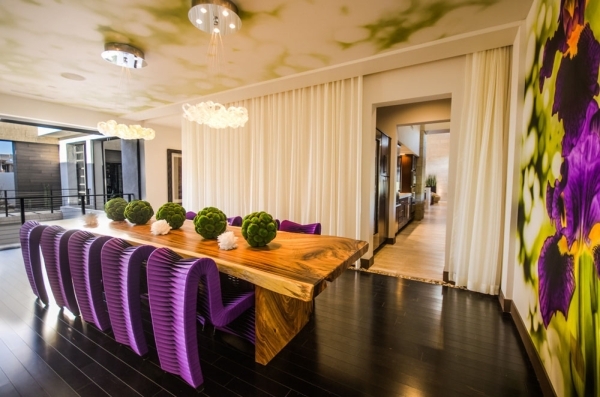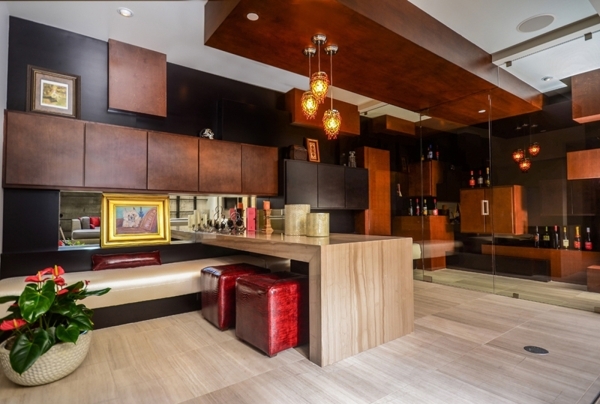Luxury homeowners trying array of strategies to save resources — PHOTOS







When Tesla’s Elon Musk announced the debut of the company’s Powerwall recently, the high-capacity battery joined a fleet of new products promising to green your luxury home, from solar-powered stereo speakers to home-management systems that track energy use. With traditional builders touting green home lines and eco-friendly custom design firms like Blue Heron enjoying increasing popularity, sustainable design is moving from the margins to the mainstream in Las Vegas.
But how do homeowners make wise decisions about which energy- and water-saving features to choose? Las Vegas’ top green architects and homebuilders say it’s about starting with a design that’s sensitive to your property’s location and climate, then incorporating the best of the innovations.
Building a green home “is a culmination of a lot of systems that are all integrated together,” said Blue Heron founder Tyler Jones. “There’s no silver bullet, and there’s no taking a poorly designed home and putting solar panels on it.”
For starters, Jones’ firm emphasizes what architects call passive solar design — positioning a house and its windows to keep heat and light in when it’s wanted, and out when it’s not. Wide overhangs, screens and louvers can keep sun away from the glass in the summertime, reducing air conditioning bills.
“Before you spend $2 on the latest gadget, you just do that properly and you’re leaps and bounds ahead of your typical home,” Jones said.
Blue Heron and other green builders use foam to insulate their homes’ walls, attic space and rooftop, sealing in the building’s ‘envelope’ to reduce energy leakage. Of course, none of that is as eye-catching as solar panels, which Jones’ firm also promotes — nearly all the homes Blue Heron builds are set up for solar power generation.
Harnessing the sun’s rays for power can be a financial gamble in Nevada, with NV Energy pushing to limit the amount homeowners can earn from selling excess electricity they generate back into the grid. Panels can also degrade over time in the Las Vegas heat, becoming less efficient. To cope with the uncertainty, custom builders often put in systems with a larger capacity than the homeowner will immediately use, allowing room to expand in the future if costs decline.
But Tesla’s Powerwall could potentially change those calculations; the super-size battery would allow homeowners to save solar-generated power for use at night, rather than selling it to the power company. Priced at $3,000 for 7kWh of storage, it’s already seeing strong demand; Musk recently told shareholders the company had received 100,000 nonbinding reservations for Powerwall and an industrial-sized version, the Powerpack.
“Fundamentally, this is about increasing your independence and reducing your reliance on the grid,” Tesla spokesperson Alexis Georgeson said of the Powerwall, which will start shipping later this year.
“People really like the look of the Powerwalls. It’s something new and unique,” said Michael Gardner, owner of Studio G Architecture in Henderson, who’s integrating the batteries into four new homes he’s developing. “Clients are definitely gravitating to it.”
Home management systems — the electronic brains that control everything from a house’s lighting and security to entertainment and climate — are becoming more affordable, and homeowners are increasingly adding energy management to the mix.
The Fusion Energy Management software from Crestron can monitor how much power a home’s solar panels are producing and compare it to energy consumption. Sensors detect whether the home is occupied, turning lighting and cooling systems down or off when owners are away.
In lighting, too, options abound. Those harsh LED lights that used to seem so much less natural than incandescent bulbs? The technology is now available in a variety of color temperatures, architects say.
Paul Steelman, owner of Las Vegas-based casino design firm Steelman Partners, recently installed a Parans lighting system in his Southern California home that uses fiber-optic cables to direct real sunlight to darker areas of the house, like stairways and closets.
“It gives the house this gorgeous, sunlit glow,” said Steelman — reducing electric bills in the process. “Everybody that sees it goes home and think it’s interesting, and they also think I’m sort of crazy for doing it.”
Builders are experimenting with gas-fired heating and cooling systems, sometimes splitting them up into several mini-systems inside one large home, to avoid the leakage that happens when air travels in ducts from one room to another. And glassmakers are producing ever-more-reflective Low-E windows that can decrease the amount of desert heat a house absorbs.
As for water, that most precious of resources in desert climates, Las Vegas homeowners are more savvy about conservation than those in many other cities, said David Baird, Director of the UNLV School of Architecture. Many have traded their lawns for desert-friendly landscaping and are using low-flow showerheads and toilets or pool covers that keep water from evaporating.
But Baird said he still sees confusion about which plants actually thrive in the Las Vegas Valley.
When many people think of desert landscaping, he said, they imagine the Sonoran Desert of Arizona and southeastern California, with its iconic saguaro cactuses.
“That area gets 8 to 10 inches more rain per year than we do,” he said. “So even when they plant ‘desert plants,’ a lot of times they have to get drip irrigation, because they need more water. Our Mojave desert landscape is also beautiful but in different ways, and it’s never been re-represented to the public in a way that makes them hungry for it.”
Gardner has pitched a pilot program to the Southern Nevada Water Authority that would study how much water could be saved by allowing homeowners to recycle gray water left over from showers and use it to flush toilets. He said the program could be especially effective for retirees and those who work from home, and that officials are considering the idea.
So what might the luxury home of the future look like?
“Ten to 12 years from now you’ll see a fully automated house with a Wink transponder that will manage your lighting and tell you whether your eggs are fresh, with everything working on Wi-Fi,” predicted Steelman. “The home will be producing energy. And you’ll see an electric car sitting in the driveway because they’re far superior.”
To achieve that greener future, builders and architects say, luxury homeowners will have to remember that just because a product is considered eco-friendly doesn’t mean it’s the best fit for their particular home.
“I’ve got clients who want to redo their kitchen and put in a countertop that has 5 percent recycled glass in it,” Baird said. “That sounds cool and looks cool but the most sustainable thing is to deal with the counter you have, when there’s nothing wrong with it.”
Which begs the question: Can a 10,000-square-foot luxury home for a single family ever truly be environmentally friendly?
“Well, the thing that’s actually doing most for the environment is dense housing in urban areas that’s energy-efficient, with people sharing resources,” said Baird, who himself lives car-free in a downtown Las Vegas high-rise.
But if well-heeled Las Vegans are going to continue to crave large spaces in which to dwell and entertain, it would be irresponsible not to do everything possible to minimize their environmental footprint, Gardner said.
“In a sense, (high-end homes) are laboratories for experimentation. You’re trying a bunch of different ideas out to figure out what could be done cost-effectively and create value for other builders.”












